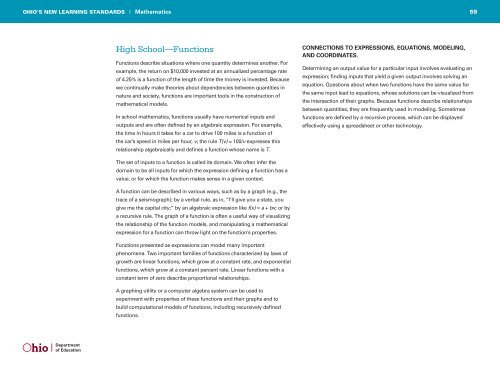Math-Standards.pdf
Math-Standards.pdf
Math-Standards.pdf
You also want an ePaper? Increase the reach of your titles
YUMPU automatically turns print PDFs into web optimized ePapers that Google loves.
OHIO’S NEW LEARNING STANDARDS I <strong>Math</strong>ematics 59<br />
High School—Functions<br />
Functions describe situations where one quantity determines another. For<br />
example, the return on $10,000 invested at an annualized percentage rate<br />
of 4.25% is a function of the length of time the money is invested. Because<br />
we continually make theories about dependencies between quantities in<br />
nature and society, functions are important tools in the construction of<br />
mathematical models.<br />
In school mathematics, functions usually have numerical inputs and<br />
outputs and are often defined by an algebraic expression. For example,<br />
the time in hours it takes for a car to drive 100 miles is a function of<br />
the car’s speed in miles per hour, v; the rule T(v) = 100/v expresses this<br />
relationship algebraically and defines a function whose name is T.<br />
CONNECTIONS TO EXPRESSIONS, EQUATIONS, MODELING,<br />
AND COORDINATES.<br />
Determining an output value for a particular input involves evaluating an<br />
expression; finding inputs that yield a given output involves solving an<br />
equation. Questions about when two functions have the same value for<br />
the same input lead to equations, whose solutions can be visualized from<br />
the intersection of their graphs. Because functions describe relationships<br />
between quantities, they are frequently used in modeling. Sometimes<br />
functions are defined by a recursive process, which can be displayed<br />
effectively using a spreadsheet or other technology.<br />
The set of inputs to a function is called its domain. We often infer the<br />
domain to be all inputs for which the expression defining a function has a<br />
value, or for which the function makes sense in a given context.<br />
A function can be described in various ways, such as by a graph (e.g., the<br />
trace of a seismograph); by a verbal rule, as in, “I’ll give you a state, you<br />
give me the capital city;” by an algebraic expression like f(x) = a + bx; or by<br />
a recursive rule. The graph of a function is often a useful way of visualizing<br />
the relationship of the function models, and manipulating a mathematical<br />
expression for a function can throw light on the function’s properties.<br />
Functions presented as expressions can model many important<br />
phenomena. Two important families of functions characterized by laws of<br />
growth are linear functions, which grow at a constant rate, and exponential<br />
functions, which grow at a constant percent rate. Linear functions with a<br />
constant term of zero describe proportional relationships.<br />
A graphing utility or a computer algebra system can be used to<br />
experiment with properties of these functions and their graphs and to<br />
build computational models of functions, including recursively defined<br />
functions.


